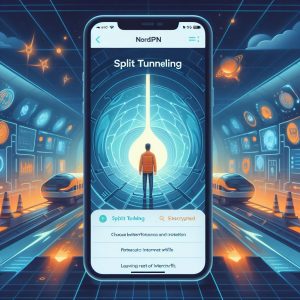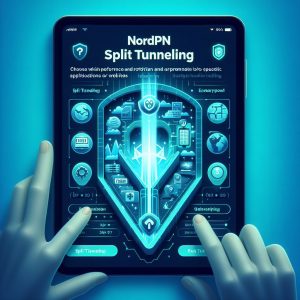Introduction
Virtual private networks (VPNs) have become an essential tool for protecting online privacy. By routing internet traffic through an encrypted tunnel, VPNs allow users to browse the web and access online content more securely. However, sometimes routing everything through a VPN can cause connectivity issues when trying to access local network resources or can reduce internet speeds.
This is where split tunneling comes into play. Split tunneling divides internet traffic into two channels – one encrypted through the VPN and one outside the VPN tunnel. This allows users to customize which apps and network traffic get routed through the VPN tunnel versus bypassing the VPN.
NordVPN provides a reliable split tunneling implementation across Windows, MacOS, iOS, Android, and Linux platforms. We’ll take an in-depth look at how NordVPN’s split tunneling works, outline the benefits it offers, provide configuration guidance, and assess how it compares to alternatives from other leading VPN services.

What is NordVPN Split Tunneling?
Split tunneling refers to intelligently directing some internet traffic through a VPN tunnel while allowing other traffic to flow outside the tunnel. This differs from the default VPN behavior that encapsulates all traffic regardless of function.
With split tunneling properly configured, VPN encryption gets applied only to sensitive applications and traffic types. Simultaneously, non-sensitive network packets transmit outside the VPN tunnel.
Dividing Traffic into Encrypted & Unencrypted Streams
Here are some examples of how VPN split tunneling divides traffic:
- Web browsers route through the encrypted VPN tunnel to protect general internet browsing activity.
- Video streaming apps also utilize the VPN tunnel to prevent ISP throttling and access geo-restricted content catalogs.
- Meanwhile, printer and file sharing services bypass the VPN to avoid connectivity issues that often arise when accessing local network resources through VPN links.
The split tunneling functionality built into the NordVPN platform allows custom configurations like these examples above. Users can fine-tune settings so specific apps or network traffic types leverage the VPN, while exempting other activity.
Advanced users can even configure split tunneling based on IP addresses or URLs. This grants precision control over exactly which network packets get encapsulated by the VPN.
Types of Split Tunneling Offered by NordVPN
NordVPN accommodates various split tunneling implementation styles. The needs of power users differ drastically from casual VPN subscribers. So NordVPN provides flexible options to cater to different requirements through split tunnel configurations.
Standard Split Tunneling
The most common split tunneling setup exposes local subnet traffic outside the VPN while pushing everything else through the encrypted tunnel. This allows accessing printers, media servers, Chromecasts, and other local networked devices without VPN interference.
Meanwhile browsing, streaming media, gaming, and non-local traffic transmits through the VPN tunnel to retain privacy and security. NordVPN enables quick standard split tunneling setups during initial configurations.
Application-Based Split Tunneling
For more advanced control, application-based split tunneling defines individual apps to flow through or bypass the virtual private network. App traffic gets managed on an individual basis depending on sensitivity.
Windows and macOS users can designate specific applications to always route outside the VPN. So chat, conferencing, and collaboration tools that struggle with VPN connections work smoothly while still protecting general web activity.
URL & IP-Based Split Tunneling
The most customizable variant involves cherry-picking traffic down to the IP address or URL level. For example, users can set the VPN to secure connectionsолько to certain sites or services while permitting everything else to transmit directly.
Likewise IP address ranges can get defined for encapsulation by the VPN tunnel or set to bypass it. This allows rigorously controlling encryption down to directing single web properties and endpoints.

Benefits of NordVPN Split Tunneling
Now that we’ve covered the mechanics of how NordVPN’s split tunneling works, let’s explore some of the major advantages it offers users.
Maintain Local Network Access
One of the most common split tunneling use cases involves maintaining local network access. When connected to a VPN, devices often lose the ability to connect with smart TVs, media centers, gaming consoles, printers, and other local services. Why? Because these items typically use internal IP addresses or mDNS hostnames that get obscured by the VPN.
Split tunneling fixes this by pushing traffic to local subnets outside the VPN tunnel, while non-local traffic transmits via the VPN encryptor. NordVPN makes configuring such split tunnel bypass rules quick and straightforward.
Improve Internet Speeds
VPNs sometimes reduce internet speeds due to factors like added data encryption overhead and more convoluted network paths. Exposing traffic that doesn’t require privacy or geo-masking can offset these VPN throughput impacts.
Split tunneling avoidsneedlessly burdening innocuous traffic with the speed tax of VPN transmission when privacy proves unnecessary. Downloads, video calls, online chats and other bandwidth-needy activities operate faster direct instead of routing through VPN servers unnecessarily.
Bypass Geo-Restrictions
Certain sites restrict content access based on geographic location detected via IP address. However strict VPN routing can also block sites that attempt geo-IP blocking, since all traffic originates from the VPN provider’s IP range.
NordVPN split tunneling offers a clever solution – non-restricted traffic avoids the VPN altogether eliminating geography conflicts, while geo-blocked access uses the VPN tunnel to spoof a permitted location. This bypasses limitations in a responsive manner based on where individual sites allow or deny visitor access.
How to Enable NordVPN Split Tunneling
The process for enabling NordVPN split tunneling varies somewhat across device platforms. We’ll outline the steps for the most common operating systems.
Windows and macOS
The split tunneling implementation works similarly between Windows and macOS using the NordVPN desktop app.
- Launch the NordVPN settings dialog via the system tray icon
- Navigate to “App Settings”
- Toggle the switch for “Allow LAN Traffic” to enable split tunneling
- Expand advanced settings to add individual apps to always bypass the VPN tunnel
That’s the basics to get started. You can further customize configurations by adding exceptions based on process name, file path, IP address and more all within the App Settings.
iOS and Android
Configuring split tunneling on iOS and Android leverages the NordVPN mobile apps.
- Tap the hamburger menu icon to launch the side drawer
- Choose “Settings” near the bottom
- Scroll down to the “Split Tunneling” section
- Enable the on/off toggle for activating split tunneling
- Add apps and services to define routing in/out of the VPN tunnel
This exposes the basics of split tunnel functionality. You can dig deeper into exclude lists and termination triggers based on SSID, location services, and connection disruption.
Linux
Linux split tunneling uses configuration text files to define routing inclusions/exclusions within the OpenVPN instance interfacing NordVPN.
- Edit /etc/openvpn/client/client.conf
- Add or modify “route” and “route-exclude” sections listing IP subnets or app endpoint destinations
- Restart OpenVPN client daemon
Now traffic matching the exclusions transmit outside the VPN, while all else gets pushed through the NordVPN encryptor.

Troubleshooting Split Tunneling
Like most VPN-related capabilities, split tunneling introduces potential connectivity quirks. App traffic allowed outside the VPN tunnel depends on default gateway and name resolution settings. Misconfigurations often manifest as inability to access internet resources outlined for split tunnel exclusions.
Double check Windows firewall permissions, browser proxy settings, DNS server arrangements, and any client app VPN plugins which could conflict with split tunnel settings. Also confirm hostnames properly resolve to internal IP addresses for local domain resources designated to bypass the VPN.
For apps defined to route outside the tunnel, verify they do not contain embedded functions that could independently invoke VPN usage. Occasionally apps have integrated subcalls for analytics, crash reporting or other phone-home traffic that ignores custom split tunnel settings.
How NordVPN Split Tunneling Compares
Among VPN industry leaders, split tunneling features see fairly consistent implementation across major providers like ExpressVPN, CyberGhost, Private Internet Access and other top-tier services.
Almost all offer a variation on selectively routing traffic through or around the VPN tunnel based on characteristics like app name, domain, or IP address/subnet. NordVPN stands out via their intuitive ease of setup for enabling split tunneling across clients, and granular policy definitions controlling flow at the individual app level.
Let’s compare with a few specific competing platforms:
- ExpressVPN – Uses TrustedServer network to simplify local resource access via split tunneling. Lacks app-based tunnel exclusions of NordVPN.
- CyberGhost – Split tunneling embedded directly in desktop apps. Less customizable than NordVPN but simpler interface.
- TunnelBear – More consumer-oriented VPN lacks advanced split tunneling capabilities seen in NordVPN.
When it comes to flexible and customizable split tunneling execution, NordVPN delivers among the most responsive implementations in large part thanks to tightly integrated split VPN options across its various desktop and mobile client apps.
Conclusion
As bandwidth-intensive internet activity and locally networked smart devices continue proliferating in homes and businesses, split tunneling holds growing significance for balancing security with speed and accessibility. NordVPN provides a top-tier VPN platform to enjoy the best of both worlds.
Their split VPN tunneling coordination seamlessly segments sensitive and non-sensitive traffic. User-friendly controls built into NordVPN client apps for Windows, macOS, iOS and Android make configuring split tunneling straightforward while offering customization options for power users.
With increasing threats to privacy from surveillance and cybercrime, the encrypted protection of VPNs remains vitally important. NordVPN split tunneling allows tailoring exactly which resources transmit through secure VPN channels versus faster unencrypted networking. This maximizes both privacy and practical usability.